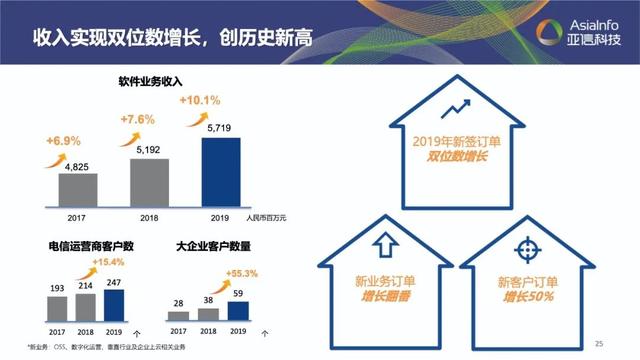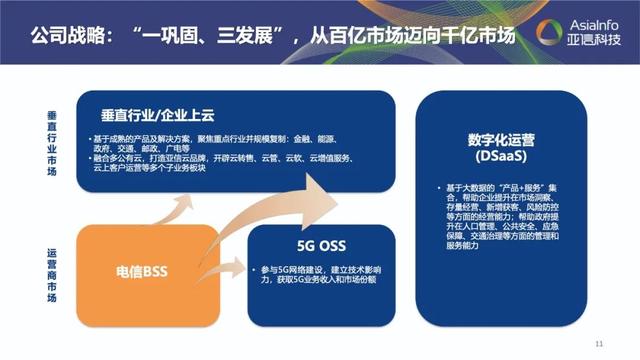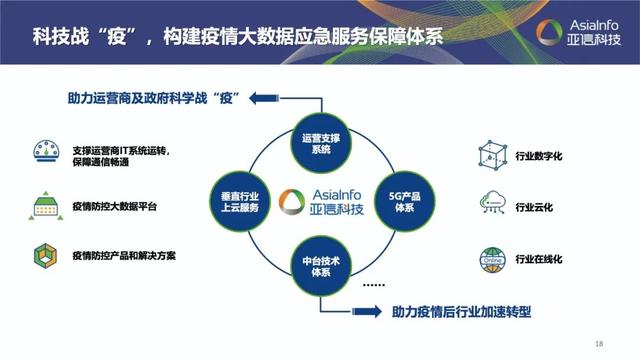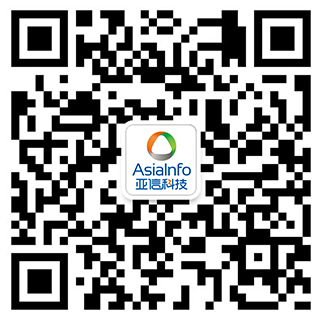On March 23, AsiaInfo Technologies Limited (known as AsiaInfo, stock code: 01675.HK) announced its 2019 annual results. The report shows that the revenue of AsiaInfo’s software business amounted to approximately 5.7187 billion yuan, representing an increase of 10.1% as compared with last year, of which the earnings from the data-driven operation services business increased dramatically to nearly 151.7 million yuan with a year-on-year growth of 83.9%. In addition, the adjusted net profit margin was 11.8%, 0.2% higher than the previous year, and its profitability reached the new high in the past three years.
There is no doubt that AsiaInfo has made great achievements in the past one year, and the “1+3” development strategy is steadily advanced. In particular, the company is gaining momentum as it sustains expansion into the digital transformation market.
More importantly, the rapid growth of businesses such as digital operation services sends a signal that AsiaInfo has transformed the overall business structure based on a new driving force. This will surely lead and promote the future development of AsiaInfo, and set a solid foundation for the company to facilitate the transformation of business models.
“Looking ahead, AsiaInfo will further strengthen its software and service roles in the telecom industry, and achieve development in network intelligence, digital operations, vertical industry and access to cloud technology provided for enterprises. We wish to earn over 10 billion yuan by 2024.” said Gao Nianshu, CEO of AsiaInfo.
Make Steady Progress and March into the 5G Market
As we all know, the Ministry of Industry and Information Technology issued licenses for the commercialization of 5G to three major telecom operators (China Telecom, China Mobile and China Unicom) and China Broadcasting last year. This makes China the fifth country to access to 5G services after South Korea, US, Switzerland and Britain, which marks China’s formal entry into the 5G era.

Against this background, on the one hand, AsiaInfo starts to provide telecom operators with 5G network and IT support systems, and it takes an active part in relevant top-level design too. Meanwhile, the company continues to consolidate its leadership in the BBS market. The report shows that AsiaInfo currently serves 247 telecom operators, up 15.4% year-on-year, and it has achieved a customer retention rate of more than 99% over the years.
On the other hand, AsiaInfo also expands its business to the 5G OSS market. In June last year, it put forward the technical strategy of three “Global Domains” (i.e. global virtualization, global intelligence and global perceptibility) based on the structural changes that 5G technology has brought to networks, applications, business operations and people’s lifestyle. Then it launched six new product lines in response to the new demands arising in the 5G era.
At the same time, AsiaInfo continued to deepen its 5G pilot cooperation with R&D institutions and provincial subsidiaries of the three telecom operators. So far, it has carried out 17 pilot projects of 5G’s commercialization, 9 of which were done in the first half of 2019. Besides, thanks to the strategic arrangement made in advance, AsiaInfo’s revenue of 5G network intelligent orders is able to exceed tens of millions yuan. It has undertook the projects of different network management systems (NMS), including the first commercial carrier-level 5G network slicing manager system in China, the first SDN NMS that belongs to a telecom operator, and the 5G NR wireless NMS that can be applied to the whole network.
In the view of AsiaInfo’s CTO, Ouyang Ye, the 5G market in China is still in the stage of steady growth. The most important reason behind this argument is that the infrastructure construction of the 5G network just starts out, and it is only limited to network coverage. The lack of killer apps also makes it harder to spark a short-term stimulus in the 5G market.
But we must be aware that the past one year has seen a lot of encouraging changes in 5G. First of all, we can see that the 5G network has the advantages of large bandwidth and low latency, thus gradually promoting the integration of some applications (e.g. VR/AR, machine vision and AI) and industries like manufacturing, healthcare and transportation. 5G has emerged as a new engine that drives the digital transformation of all industries, and a powerful catalyst for new business opportunities.
Therefore, every service provider has to figure out how to prepare telecom operators for the future competition. Ouyang Ye noted that AsiaInfo has two unique competitive advantages as follows.
The first one goes to its network neutrality. AsiaInfo does not involve investment in telecommunication hardware, so it can help operators establish a network management system characterized by network neutrality and independent management of operations and suppliers. Effective network management and orchestration (MANO) as well as network evolution can be guaranteed in this way.
Secondly, the company has a competitive edge in software development capability. As network virtualization is becoming an irresistible trend, AsiaInfo launched white-box software products and solutions, so that telecom operators can operate within a virtualized, automated and intelligent system without relying on specialized hardware offered by traditional equipment providers. And in doing so, modular operation stations can be built to bring down costs.
Given its advantages mentioned above, AsiaInfo remains as a BSS market leader and has the foresight and ability to explore the OSS market. Besides, the company maintains its network neutrality when stepping into the 5G market. With the increasing development of the 5G market, I believe that AsiaInfo will play a greater role in the construction of 5G and also create more value for the whole market.
Admittedly, enterprises will also face the difficulty of decision-making and management dilemma as 5G technology is increasingly applied to different industries. Service providers have to opt for the proper 5G network configuration among the four telecom operators, and develop scientific management of the use of 5G within enterprises. Without question, AsiaInfo is qualified if viewed from these two aspects.
Forge Ahead into the Future and Enhance All-round Competitiveness
Cloud computing has introduced revolutionary changes in the traditional IT industry, and the new architecture and service model coming with it are widely accepted by more and more enterprises. Although the IaaS model still dominates the cloud services market, SaaS and its cloud services market is rising rapidly.

With an insight into this dramatic change, AsiaInfo began to plan for the possible situation a few years ago and increase its investment in data-driven SaaS (DSaaS), vertical industries and enterprises’ access to cloud technology.
Firstly, AsiaInfo’s DSaaS products and services include the product series of Smart Connection (IoT connectivity oriented), Smart Info (social operation tools like WeChat), Smart Operation (business growth oriented) and Smart Sharing (scenario-based operation tools that rely on operators’ big data).
As I learned from Li Yunchuan, vice president of AsiaInfo, the core of DSaaS is to assist enterprises in refined and efficient operations based on data resources and data technology. Enterprises can then reduce costs and connect themselves to a wider market.
At present, DSaaS products and services are mainly offered to governments, finance, energy, automobile, retail and other industries. In the future, more small and medium-sized enterprises will be beneficiaries as well. Besides, AsiaInfo charges customers for DSaaS products and services flexibly (subscription, share revenue and performance-based payments, etc.).
According to Li Yunchuan, AsiaInfo attaches great importance to this new business and even set up a business unit specializing in the development of DSaaS in 2017. This can enable the company to quickly gather manpower and resources needed for the business success.
Figures demonstrate that the revenue of DSaaS business amounted to 151.7 million yuan, a year-on-year growth of 83.9%. This may represent a smaller share of the total revenues, but it is quite impressive when compared with other market players. And the annual growth rate of over 80% promises a bright future indeed. This proves that AsiaInfo’s new development strategy has achieved initial success.
Secondly, vertical market sectors in China are no longer limited to the application of information technologies. Instead, they begin to equip themselves with digital and intelligent weapons. In this process, 5G+ABCDT (Artificial Intelligence, Block chain, Cloud Computing, Big Data and IoT) technologies have become key driving forces. Relying on these technologies, AsiaInfo stepped into the industrial application market.
Li Hui, vice president of AsiaInfo, said, “Our technical strengths that have been built up in serving telecom operators have set a solid foundation for the expansion into the vertical market. Now we are making use of our technological advantages to suit the needs of each industry, so that employees, customers and enterprises can benefit from our products and services with lower costs and higher efficiency.
Currently, AsiaInfo mainly serve postal, banking, insurance, radio and television, finance, energy and retail industries. Over the past year, the company has gained high recognition from customers in cooperation on many large-scale projects, and it has established good relationship with large enterprises based on mutual trust. According to AsiaInfo’s financial report, as of the end of 2019, the company has provided services to 59 enterprises outside the telecom industry, an increase of 55.3% compared with the same period last year. And the customer retention rate remained at a high level (more than 99%) over the years.
In the view of Chen Haixia, vice president of AsiaInfo, AsiaInfo cannot quickly enter into industries like energy and have the capacity to compete in the market without the following three drivers.
First, relying on its technical strengths in the database, data middle-layer operating system, as well as data analysis and intelligent analysis products and technologies, AsiaInfo can serve its clients with better solutions. Second, AsiaInfo has well-established advantages in the telecom operator market. As 5G network is applied to more industries, the company will quickly help its clients in different industries operate within the 5G network. Third, as China’s largest telecom software product and service provider, AsiaInfo has provided quality services to many clients, and in the future, its intelligent O&M products can also be a great helper for clients in different industries.
Last but not least, when providing enterprise with access to cloud technology, AsiaInfo is picking up its pace to be a cloud MSP (management service provider). In 2019, AsiaInfo partnered with Alibaba Cloud Computing in MSP and Huawei in CSSP cloud service solutions. In the future, the company will establish business ties with more cloud service vendors to offer hybrid cloud and multi-cloud management services.
On the one hand, as a cloud MSP, AsiaInfo can provide customers with cloud consulting, cloud planning, cloud migration and cloud O&M services, thus shifting business operations from traditional architecture to cloud platforms. On the other hand, AsiaInfo also enhances its capabilities of cloud product development when providing enterprises with access to cloud technology. It has launched relevant cloud management platforms and cloud access tools to create a market featuring cloud and AI technologies. In the future, the company will support enterprise with more cloud products and services that are used within a new cloud ecosystem and platform, as explained by Cao Weiqi, Vice President of AsiaInfo.
It is worth mentioning that the new business of AsiaInfo also played a significant role during the COVID-19 outbreak. Take one of AsiaInfo’s clients as an example. Thousands of its stores suffered in the wake of the epidemic. But with the help of AsiaInfo, the client integrated its physical store business with online business by digitizing and transferring the customer resources to online platforms. By using this method, its employees could still work online and generate profits. This model proved to be effective, and that highlights the value of AsiaInfo’s Smart Info solution.

In fact, AsiaInfo does not just serve as an enabler for enterprises. During the epidemic outbreak, AsiaInfo leveraged its capabilities in communication big data and AI technology, and assisted governments and organizations in epidemic prevention and control. It is learned that AsiaInfo divided the overall epidemic control into five stages: epidemic perception, epidemic awareness, epidemic prediction, anti-epidemic command, epidemic prevention and resumption of work. Based on these five stages, AsiaInfo has made full use of its basic capabilities in big data and communication artificial intelligence to quickly bring 16 products and solutions to the market.
All these efforts that AsiaInfo devoted in emerging businesses do not just satisfy the current demands, but also cater to the needs of future growth. We have reasons to believe that AsiaInfo will fully unleash its potential in winning the competition in the digital and intelligent transformation market targeting different industries in China.
Set Sail at a Faster Pace for Innovation
AsiaInfo’s “1+3” strategy has been advanced steadily, and it can not do without the substantial investment in R&D. The 2019 annul results reveal that the total investment in R&D last year added up to 819 million yuan, an increase of 45.5% compared with a year earlier. This allows AsiaInfo to stay ahead of competitors and remain competitive in the field of technology and product development.
In this regard, the CTO of AsiaInfo, Ouyang Ye noted that the company will focus on three “Global Domains” (global virtualization, global intelligence and global perceptibility) in the future, and priority will be given to five R&D directions as follows.
First, digital middle-layer operating system has gained popularity in the past year, and it is now receiving widespread attention of telecom operators. This year, AsiaInfo will help the three telecom operators gradually build a mature middle-layer operating system relying on its experiences and past achievements in this field.
Second, 5G network intelligence will be a development focus. AsiaInfo hopes to make an intelligent 5G network management and network O&M a reality, and to automate billing systems, IT systems and network systems. Eventually, the intelligent network and business operation will contribute to better user experience among telecom operators and end users. Third, AsiaInfo will enhance its ability of cloud product development by providing cloud management platforms and tools with access to SaaS.
Fourth, AsiaInfo will integrate BSS and OSS technologies in a virtualized and intelligent way to build a new generation of ecosystem with 5G network as the core. Fifth, AsiaInfo aims to empower communication artificial intelligence with more automated and intelligent functions, so that it can operate well in the 5G ecosystem, production system and business system.
We can easily find that AsiaInfo has invested in the technology development a lot, both in its scope and depth, which is far more than the industry expected. Just as the competition for market relies largely on product innovation, strategic innovation should be driven by more advanced technologies. Therefore, the existing technical reserve of AsiaInfo is bound to lay a more solid foundation for its future development.
To sum up, AsiaInfo is blazing a new trail of development in line with the “1+3” strategy. As the company fully promotes 5G applications, digital operation services and enterprises’ access to cloud services, it will undoubtedly accelerate the construction of “New Infrastructure” and technological upgrades in society. It is fair enough to say that AsiaInfo will bring us closer to a Digital China.






